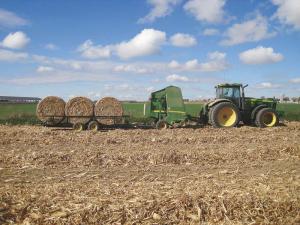2012 - Volume #36, Issue #6, Page #19
[ Sample Stories From This Issue | List of All Stories In This Issue | Print this story
| Read this issue]
Former Deere Engineer Specializes In "Niche" Forage Equipment
 |
Clark left his Deere job and returned to his parent’s farm in 2005, where they leased him a pole barn where he could start his own business. “That was the start of RCI Engineering, and it’s really progressed from there,” Clark says.
His first equipment out the door was a mounting kit to install a 30-ft. wide 900D series Deere draper head on a Deere 6000 or 7000 series self-propelled forage harvester. “This was a very specialized application that allows the harvester to achieve more capacity, direct cutting a wider swath,” Clark says. “Our kit provides sufficient oil flow from the base machine to drive the reel and it also provides cab controls for the draper and reel speed.” The kit includes a flow divider and flow control valve and all other components needed to adapt the draper to the quick coupler, drives and frame connection on the harvester. The kit is sold primarily to forage producers in the Western U.S. and Alberta.
After the success of that equipment, Clark developed a swath merging device that mounts underneath a self-propelled windrower, a pickup attachment for a 3975 pull-type harvester, and a round baler tandem axle kit. Those products are sold through Deere dealers, but RCI develops and manufactures the equipment and provides technical support. Within a few years, the company moved to a new manufacturing facility near Mayville, Wis. Clark has four full time engineers who help RCI fulfill its role as an allied supplier to Deere and also build custom equipment for other companies.
“We’ve found a real niche in the marketplace,” Clark says, “and the growth has been very steady.” He credits his success in part to being in the right place at the right time, meeting his wife Wendy (who also worked for Deere), and then developing a shared vision.
Another RCI design that’s gaining a foothold is the 35A Round Bale Accumulator. “We partnered with a farmer who had a working concept that he’d been developing for several years,” Clark says. “We made many improvements to the design, improved the function across varying crop conditions, then tested it locally and in Canada. Those who have run it are very enthused with how it works.”
The 35A Accumulator trails directly behind a round baler and holds three bales as they’re discharged from the baler. RCI has adaptor kits so the 35A can be used with any of the five major baler brands. The sturdy trailer has a fabricated laser cut frame and heavy-duty 31.5/13.5-15 tandem wheels. The floor is made of stainless steel so plastic-wrapped bales easily move to the back during operation. Bales move on a hydraulic floor chain controlled from the tractor. Rails on each side of the unit are adjustable to hold bales 4 or 5 ft. wide. A metal arm keeps them from rolling as the accumulator is filled.
“The Accumulator speeds up round baling because it lets the operator deposit a group of bales in one location, either in central locations on longer fields or on the headlands of shorter fields,” Clark says. “It shortens the time needed for collecting and transporting bales to a storage site and reduces trips across the field.”
The machine operates simply and efficiently. When a bale is completed, the baler door lifts and deposits it on the accumulator. As the bale clears the door, an indicator in the cab alerts the operator so the door can close and the operator can continue baling. When the accumulator is full, the rear gate opens and three bales plus the one in the baler are deposited on the ground tight together. The machine is easy to unhook so the baler can be used without it.
“We spent more than a year working on the machine and introduced it in the summer of 2012,” Clark says. “We think it’s going to be a nice addition for large operations and for custom operators who are always looking for ways to be more productive,” Clark says. Manufacturing production of the 35A began in October 2012.
Clark is already looking at other equipment to build and improve. “There’s really no end to things that can be done easier or more efficiently on the farm,” he says. “We’re really enjoying this business and the best part is we’re building things that farmers can use to make their life easier and their farms more profitable.”
Contact: FARM SHOW Followup, Randy Clark, RCI Engineering LLC, 970 Metalcraft Dr., Mayville, Wis. 53050 (ph 920 387-9804; clark@rciengiineering.com; www.rciengineering.com).

Click here to download page story appeared in.

Click here to read entire issue
To read the rest of this story, download this issue below or click here to register with your account number.




